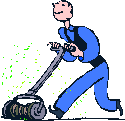Root-suckering trees can be a landscaping problem.
If you don't want to deal with root suckers (clone trees sprouting up from the roots of a "parent" tree,) don't plant the trees listed below. Some of them produce more root suckers than others, but all of them will send up shoots on a regular basis.
 If you plant them, you can control the suckers by keeping the grass mowed around them. If you aren't vigilant, you may soon have a thicket or a pure stand. If you have a small yard, your neighbors will have to deal with the constant sprouting of root suckers from your tree also.
If you plant them, you can control the suckers by keeping the grass mowed around them. If you aren't vigilant, you may soon have a thicket or a pure stand. If you have a small yard, your neighbors will have to deal with the constant sprouting of root suckers from your tree also.To help minimize root suckering, avoid any injury to the "parent" tree, such as pruning it or shearing off the tops of its roots with the lawn mower.
This is probably an incomplete list.
- Alders --Alnus
- Poplars --Populus -- cottonwoods, aspens, poplars (look for non-suckering varieties)
- Sumacs -- Rhus
- Willows -- Salix
- Black locust -- Robinia pseudoacacia
- Honey Locust -- Gleditsia triacanthos
- Sassafras -- Sassafras albidum (Nutt.) Nees
- Blackgum -- Nyssa sylvatica Marsh
- Beech -- Fagus grandifolia Ehrh.
- Southern Crabapple -- Malus angustifolia Michaux
- Wild cherries -- Prunus serotina, Prunus virginiana, Prunus avium, Prunus padus
- Wild plums -- Prunus americana
- Lindens -- Tilia
- Persimmon -- Diospyros spp.
- Pawpaw -- Asimina triloba (will create a "pawpaw patch")
- Devil's walking stick --Aralia spinosa
- Common hoptree -- Ptelea trifoliata
- Nannyberry -- Viburnum lentago
- Blackhaw -- Viburnum prunifolium
- Chinese mulberry -- Cudrania tricus pidata
- Chinese jujuba -- Zizyphus jujuba
- Juneberries -- Amelanchier spp. (serviceberries, etc.)
- White Poplar -- Populus alba
- Russian Olive -- Elaeagnus angustifolia L.
- Autumn Olive -- Elaeagnus umbellata Thunberg
- European Black Alder Alnus glutinosa -- produces root suckers and spreads rampantly by seed
- English Elm -- Ulmus procera
- Mimosa - - Albizia julibrissin -- produces root suckers and spreads rampantly by seed

 "The power to recognize trees at a glance without examining their leaves or flowers or fruit as they are seen, for example, from the car-window during a railroad journey, can only be acquired by studying them as they grow under all possible conditions over wide areas of territory. Such an attainment may not have much practical value, but once acquired it gives to the possessor a good deal of pleasure which is denied to less fortunate travelers."
"The power to recognize trees at a glance without examining their leaves or flowers or fruit as they are seen, for example, from the car-window during a railroad journey, can only be acquired by studying them as they grow under all possible conditions over wide areas of territory. Such an attainment may not have much practical value, but once acquired it gives to the possessor a good deal of pleasure which is denied to less fortunate travelers."
7 comments -- please add yours:
I would like to add to this list Buckeye. This tree suckers at the base and is a horrid nuisance in the lawn with its seeds. It has daughters popping up all over my property. Despite these shortcomings, the Buckeye is lovely in the Spring.
What do you think about the suckers from hickory trees? I love these trees and I'm trying to re-establish hickory trees in a clear-cut backyard. They are not stump sprouts but are coming straight out of the ground and growing 1-2 feet a year. Are they strong or will they eventually topple? I guess they biggest thing I'm worried about is their stability. For all I know above ground they are strong straight shoots. After 3 years 1 has grown 7 feet and is just now putting out its second flush of growth. I believe the ones I have are mockernut hickories. Thanks!
I wouldn't worry about their stability, any more than you would worry about the stability of any other hickory tree. Yes, they started as a root sucker, but they will develop their own supporting root system as they grow, just as any hickory tree does. The main thing in deciding which hickory suckers to keep would be if they are far enough away from the parent trunk -- the farther the better, in my opinion, to allow room for the branches to develop. It sounds like the suckers are doing pretty well. 7 feet in 3 years is pretty good growth for a hickory.
thanks!
I know this is an older article with older comments but I wanted to add Crepe Myrtles to the list. They have suckers which pop up all throughout my yard.
I would add the deciduous hollies-----or winterberries. They are good for wildlife, but in a landscaped garden bed, it becomes a perpetual nuisance to keep the suckers cut back.
You can also take branches on the tree, scratch them with a knife or saw & dust them with rooting hormone. Then wrap the branch where it’s dusted and wrap it with burlap and fill it with planting medium. Water the burlap regularly and in early fall you can cut the branch from the tree and plant the new root ball in the burlap and the branch becomes a new tree!
Post a Comment